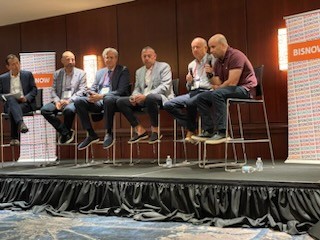The OCOLO team is still working our way through the insights shared by data center industry leaders during the many rich panel discussions offered throughout the two-day RBC Capital Markets Global Communications Infrastructure Conference.
This LI dispatch highlights themes from another Day 1 Panel: Colocation and Connectivity Perspectives, moderated by Alexander Thomas, RBC Capital Markets
Panelists:
Tesh Durvasula – Chief Executive Officer, AtlasEdge Data Centres
Kevin Dean – Chief Executive Officer, euNetworks
Michael Reid – Chief Executive Officer, Megaport
Bill Long – Chief Product & Strategy Officer, Zayo Group
Theme 1: Evolution of Key Business Drivers
- Bill Long, Zayo – The biggest shift recently is that AI is the biggest business driver. There’s huge hyperscale demand between metros and very large fiber orders. We’ve gone from 12-24 fiber bundles before to 128-432 fiber bundles now. There’s also strong demand for GPUs as a service and going up the stack to seeing demand from Enterprises for infrastructure acceleration. Carriers by comparison have had flat budgets, as they’re waiting for fiber to tower. It’s good business but pricing is ridiculous
- Kevin Dean, euNetworks – We set timeline to 2023 onward. Then, capex expansion of hyperscalers and layoffs had impacts and capex declined by datacenters. In 2024, data center capex has gone way up. There’s an arms race today for power and data center space. If you can’t tie up power, you can’t tie up space.
- Tesh Durvasula, AtlasEdge – Carriers are very important. We’re seeing that in markets across Europe where we operate. Large enterprises are trying to scale and deploy directly into the cloud. Edge is hard to define – two is now four and four is now 20. Everyone must be ready to scale and that’s what we’re focused on.
- Michael Reid, Megaport – Data centers are exploding, specifically for the hyperscalers. We’re getting massive fiber rollouts. The GPUs must go somewhere and that’s the data centers, and it all flows through to Megaport. The VCs pumping billions into AI – a lot of that is going to GPUs as a service. We built an AI exchange to on-ramp clients. There’s huge demand for on-ramping to that space as customers looking to move their data, and there are crazy costs associated with it.
Theme 2: Moving to Remote Locations to Solve Power Constraints Issue
- Kevin Dean, euNetworks – Ideally, we want to build adjacent to other existing sites. If not, we have two other options: build further afield or re-commission an old site. We are seeing more and more movement to 2nd tier sites.
- Bill Long, Zayo – We’re actually seeing Tier 9 building taking off. Markets that didn’t even exist before are being developed now just because there’s available power. The phenomenon of “Not in My Backyard-ism” can send development to next closest markets that are 90-100 miles away – more remote locations and long-haul markets.
- Tesh Durvasula, AtlasEdge – That’s a uniquely American problem. In Europe, you’re in everyone’s backyard all the time. We’re used to the proximity.
Theme 3: Power Challenges Next 12 Months
- Michael Reid, Megaport – We’re all different companies and what they’re trying to do different things – control costs, control the market, etc. The answer is always more, whether its data centers, speed, locations, go-to-market strategy or investment back into platform. At Megaport, we have an incredible customer base and we’re unique in the market, so we have a great opportunity to pour gas on fire and run hard. No one knows how the power issue will play out long-term. No doubt the big players will continue pouring more and more into this. We’re starting to see investments flow down from hyperscalers to the Edge and beyond, and there’s so much to capture. It will continue.
- Tesh Durvasula, AtlasEdge – At the end of the day, we’re builders, just swinging a hammer. There are challenges with regulators, getting permissions, educating the world about how we do things, getting permits in Europe and otherwise. The education process is painful. Innovation moves fast, regulation and education don’t. When people don’t understand what you’re doing, they throw obstacles up. We want more permanence. As long as we have clarity, we’re all skilled operators and can work with that and plan it into our process – it’s the uncertainty that slows us down. Our request is: just don’t stop permitting for no reason.
- Kevin Dean, euNetworks – We see it as the same train, just doing more and going faster. You just have to ride the wave. The demand is only going to grow over time.
- Bill Long, Zayo – Now, it’s a land grab for chips and where to put them; next it will be fiber. There are thousands of municipalities to negotiate with for sites, for permitting on infrastructure. Dominion Energy and the Northern Virginia market is a good example of how to negotiate through a shortage quickly.

